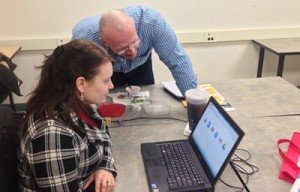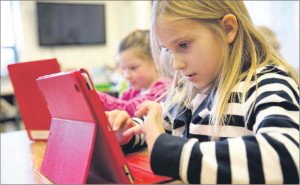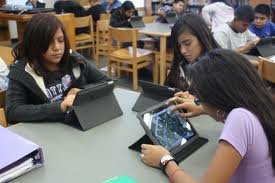eLearning Technology in the Classroom Article
eLearning Technology in the Classroom
WHAT DO TEACHERS WANT EVEN MORE THAN NEW TECHNOLOGY? TRAINING ON HOW TO USE IT
By Liz Willen
The Hechinger Report -3/14/2014
Austin, TX. – With apps for everything from annotating poetry to understanding literature through hip hop, it might have seemed teachers in attendance at the sprawling South by Southwest.edu (SXSW) festival last week were hungry for new tools and technology.
After all, a dizzying menu of new classroom technology prevailed; there was even an interactive playground to try it all out.
The RobotsLab was on hand to demonstrate math and science concepts using what else? Robots.
New products like ClassroomIQpromised to give teachers their time back by helping them grade. From Berlin came a new way to learn languages called Unlock Your Brain.
(Tim Thomas (Hereford MS Library Media Specialist) and Lisa Dai Venker (Golden Ring MS Library Media Specialist) at a professional development meeting for middle school library media specialists in Baltimore County)
Yet many teachers instead are clamoring for training on how to use this new technology to do what they do best – teach.
In a new nationwide survey of more than 600 K-12 teachers, 50 percent reported inadequate assistance when using technology in the classroom, according to a survey from digedu, a Chicago company that partners with schools to integrate technology in classrooms. Some have reported feeling left out of the debate around the role of technology to improve teaching and learning.
“Teachers show up at large, industry-driven conferences feeling more than a little like middle school students at their first dance. They want to be there so badly but they are completely confused as to how they fit in and what role they should adopt,’’ Shawn Rubin of EdSurge wrote in a column after last year’s festival.
It should come as no surprise that in a new nationwide survey of more than 600 K-12 teachers, 50 percent reported inadequate assistance when using technology in the classroom. Something of a backlash followed. As my colleague Anya Kamanetz points out, the SXSW festival this year not only drew more teachers, but also had plenty of students.
I found many teachers with lots of questions and strong opinions. In one panel entitled “When Does Ed Tech Just Become Education,” an audience member stood up and angrily denounced the absence of a teacher on the panel. The crowd cheered. I couldn’t help wondering how teachers are adopting to a whole new way of delivering education known as “convergence,’’ – a phrase describing the transition to digitally focused classrooms that Miami-Dade County Schools Albert Carvalho spoke passionately about in a keynote address.
Teachers also must adapt to new devices and techniques like blended learning, aimed at giving students more control over where, how and when they learn – often partly online. Some schools offer incentives for teachers; I also heard a lot about “blended learning coaches,’’ to help with digital transitions.
But what happen if teachers are resistant? The question came up during a panel entitled “Go Big or Go Home: Scaling Personalized Learning.’’ A reply came quickly from Kenneth Eastwood, superintendent of schools in Middletown, who has been recognized as one of the “Top Ten Tech Savvy Superintendents,” by eSchool News.
“Teachers who use technology will replace those who don’t,” he replied.
It’s a lot more complicated, of course, as Benjamin Herold of Ed Week notes in his recent story on the challenges school districts face when they want to run or replicate schools with a technology-based focus.
After the conference was over, I put in a call to S. Dallas Dance, another tech-savvy superintendent who is immersed in the digital world and wants make sure teachers are ready to meet students in it. In Baltimore County, he’s pushing the district of 174 schools (he’s visited all of them) toward a digital conversion; he’s also identified specialists “who have to be fully knowledgeable about instruction and [have] a willingness to learn how to imbed technology’’ into classrooms, he said.
Dance acknowledged that some teachers are resistant, but more are enthusiastic. He added that it helps to keep the focus on curriculum and training – especially in a district where all students will soon have a digital tablet to bring to school.
“Curriculum drives it; not the device,’’ Dance said. “The sticking point is training to make it work. If [school systems] think of it as a device, things will get dicey. It is what you are trying to do through the device that counts.”
COMMENTS
3/14/2014
While serving as the director of technology for a large urban/rural school district I purchased SmartBoards for every school and held extensive training using train the trainer model. The intent was for the trained teachers to go back to their schools and train their colleagues. I retired in 2009. I came back to be an elementary principal in the same district. I found the smart board I had purchased hiding in a closet, the cables missing, and the projector in use in a classroom with a document camera. This is typical of what happened with the smart boards throughout the district. I told my staff yesterday that we will be purchasing items to fill their technology needs, but I was reluctant to purchase smart boards as I did not see them being used effectively. A teacher asked, “Was there ever any training done on how to use the Smart Board?”
The training provided did not make it back to the school, and training opportunities are difficult to find. Mandated training is resented, and voluntary training is poorly attended. Yet teachers complain that the do not have the latest technology!
LEGISLATORS CALL FOR IMPROVED SCHOOL, LIBRARY INTERNET
By Glenda Anderson
The Press Democrat 12/31/2013
Rep. Jared Huffman, D-San Rafael is among members of Congress pushing FCC to modernize services. More than two dozen members of Congress have signed a letter calling for upgrades to a federal program that subsidizes Internet access at schools and libraries. “The program hasn’t kept pace with changing technology,” Huffman said in a statement. Most schools currently have Internet access but their connections are too slow to accommodate the latest in computerized educational tools, according to the letter sent to the Federal  Communications Commission. The commission, which oversees the E-rate program, agrees it should be updated to provide faster Internet service. In July, FCC officials announced plans to review and modernize the program, which has been in operation since 1997. It was unclear Monday how much the proposed upgrades would cost. FCC officials said that’s one aspect of the program they are studying.
Communications Commission. The commission, which oversees the E-rate program, agrees it should be updated to provide faster Internet service. In July, FCC officials announced plans to review and modernize the program, which has been in operation since 1997. It was unclear Monday how much the proposed upgrades would cost. FCC officials said that’s one aspect of the program they are studying.
The program currently costs $2.3 billion annually. The costs are borne primarily by customers of telecommunication companies that provide interstate or international services. It’s one of four programs funded through the Universal Service fees customers are charged on their monthly bills. Altogether, the four programs add up to about $8.5 billion annually, according to the FCC. Universal Service fees have more than doubled over the last decade to about 15 percent, according to the New York Times. Other programs funded though Universal Service fees include telecommunications subsidies to low-income residents, rural health centers and rural areas in general.
Critics have said the fees that support the E-rate program are hidden taxes. Supporters say the program is crucial to students’ success in school and their futures in a competitive job market and world. “Adequate broadband is an equity issue that must be achieved to ensure that all students, rural, remote and urban, have the opportunity to receive a quality education to graduate from high school college- and career- ready,” said Mendocino County Office of Education Superintendent Paul Tichinin. The program provides subsidies of between 20 percent and 90 percent to eligible recipients. The larger subsidies go to schools and libraries that are rural and have high poverty rates, according to the FCC.
BROADBAND BACKUP: SCHOOLS STRUGGLE TO STAY CONNECTED
By Kimberly Hefling
Associated Press 12/5/2013 80% of facilities said to lack adequate Web access; Gates, Zuckerberg donate $9M to effort
Needed to keep a school building running these days: Water, electricity — and broadband. Interactive digital learning on laptops and tablets is replacing traditional textbooks in many cases. Students are taking computer-based tests instead of fill-in-the-bubble exams. Teachers are accessing far-off resources for lessons.
Technology is changing the way students are taught — and tested. But there’s a catch — most of it is occurring in schools that have rich connectivity to the Internet. Although nearly every school has Internet access, classrooms frequently are not connected or the connections are super slow. The hurdle is limited capacity inside schools to transmit data, or bandwidth. “It’s the backbone. We have to actually think not just about the sustainability of the current traffic, we’re talking about exploding traffic,” said Raj Adusumilli, assistant superintendent for information services in the Arlington Public Schools in northern Virginia.
The effort to get high-speed Internet access in every school got a boost Wednesday from the philanthropy of two technology gurus — Facebook creator Mark Zuckerberg and Microsoft co-founder Bill Gates. Zuckerberg’s Startup: Education and Gates’ foundation have contributed a combined $9 million to the nonprofit EducationSuperHighway, a San Francisco-based nonprofit organization working to improve connectivity in schools. “When schools and teachers have access to reliable Internet connections, students can discover new skills and ideas beyond the classroom,” Zuckerberg said in a statement. The funds are expected to be used to provide technical expertise to schools and use competition to help drive costs down. It likely would cost billions to get highspeed Internet access to every school in America.
President Barack Obama this past summer set a goal of having 99 percent of students connected to high-speed Internet connections within five years. Also, the Federal Communications Commission is weighing changes to a program to increase connectivity in schools. Today, about 80 percent of schools have Internet capabilities that are too slow or isolated to places like front offices and computer labs, said Richard Culatta, director of education technology at the Education Department. Many schools have the same amount of connectivity as an average home. That means several hundred kids or more operate on an Internet connection similar to that used in a house by four family members. That leads to networks that are slow and prone to crashing.
 “There are many examples of fantastic things happening across the country, but they are happening in places where infrastructure is in place that supports these types of innovations,” Culatta said. At Jamestown Elementary School in Arlington, Va., first and second-graders use iPads to document the growth of caterpillars for a science project or record themselves reading out loud as they make electronic books. “It’s fun. You can draw and make books and movies,” said 7-year-old Braeden Meeker. “We learn writing and math. We learn a lot of things.” But one day in class, the system crashed when students tried to look up their house on a Google map.
“There are many examples of fantastic things happening across the country, but they are happening in places where infrastructure is in place that supports these types of innovations,” Culatta said. At Jamestown Elementary School in Arlington, Va., first and second-graders use iPads to document the growth of caterpillars for a science project or record themselves reading out loud as they make electronic books. “It’s fun. You can draw and make books and movies,” said 7-year-old Braeden Meeker. “We learn writing and math. We learn a lot of things.” But one day in class, the system crashed when students tried to look up their house on a Google map.
The district has upgraded to high-speed broadband, or Internet access that is always available and faster than dialup, in middle and high schools and is in the process of doing the same in elementary schools. The goal is to assign a device to each student by 2017. In some districts, particularly rural ones, cost is a huge factor in getting access to lines that would bring broadband into schools. To buy the equipment and install Wi-Fi costs an estimated $30,000 to $50,000 per school and to run fiber optics into the school can cost tens of thousands more per mile, said Evan Marwell, CEO of EducationSuperHighway.
A lack of competition for broadband access helps drive up costs at Chautauqua County Unified Schools, a district with about 360 students in an agriculture and oil community in rural Kansas. About three-quarters of students in the district qualify for free or reduced lunches. The district relies on distance learning to teach Spanish, physics and calculus and has issued an iPad to all students in upper grades, said Nancy Pinard, the district’s technology director. Its broadband bill would be about $9,000 a month without a special Federal Communications Commission program that reduces it to $2,000 to $3,000 a month.
“My big thing is the cost of it,” Pinard said. “How long will we be able to maintain where we are at just because of the cost.” The drive for increased broadband capabilities has been fueled in part by a drop in the price of tablets and their rising popularity, said Doug Levin, executive director of the State Educational Technology Directors Association.
L.A. SCHOOLS PAYING $768 PER STUDENT FOR IPADS
LOS ANGELES 1/2/2014 The Los Angeles Unified School District spends more to equip students with tablet computers than other school districts, which choose less expensive devices, according to a report. LAUSD is paying $768 apiece for an iPad for its students, teachers and administrators. Meanwhile, the Perris Union High School District spends $344 for a Chromebook for each student, while Riverside Unified opts for cheaper devices like the Kindle Fire and iPad Mini, the Los Angeles Times reported.
LAUSD is paying $768 apiece for an iPad for its students, teachers and administrators. Meanwhile, the Perris Union High School District spends $344 for a Chromebook for each student, while Riverside Unified opts for cheaper devices like the Kindle Fire and iPad Mini, the Los Angeles Times reported.
Across the nation, schools are embracing technology and increasingly providing students with tablets in the hopes that they will become more engaged in learning. At the same time, schools are trying to hold down costs by buying cheaper models or leasing them.
Not only did LAUSD choose a higher-end Apple iPad, but the district also paid to have new math and English curriculum pre-loaded on the tablets. Schools Superintendent John Deasy defended the decision. “Our youth deserve the best we can afford.”
THREE STUDENT SUCCESSES WITH IPADS
By Anya Kamenetz
Hechinger Report October 24, 2013
The last time I wrote about iPads in the classroom, it was about a school district doing almost everything wrong. Today I talked to a teacher in the Chicago Public Schools who has a 180 degree view.
When the iPad first came out in 2010, Jennie Magiera made fun of her friends for buying them: “Nice job–you got a giant iPhone that can’t make phone calls!!” But when a grant bought iPads for her fourth and fifth grade class, the teacher quickly found a path to transforming her teaching and learning practice. While tests are only one measurement of success, she went from having just one student out of 15 “exceed” on state tests in fourth grade, to having 10 “exceed” the next year.
Just three years later she has gone from the classroom to helping other teachers implement one-to-one iPad programs, as the digital learning coordinator of the Academy of Urban School Leadership, a network of 29 public (non-charter) schools that are 90% free and reduced lunch. Her focus is on using technology to make good teachers better, and to let students be the best they can be.
“I could seriously sit here till we both passed out telling stories of powerful things that happen every day,” Magiera says. Here are three of those stories.
1) The Second Grade Experts
The students in Magiera’s network are not “digital natives.” Most of them don’t have access to devices at home because of family income. Nevertheless, they are engaged by and excited about using computers, and because the teachers are learning to use them along with the students, there’s sometimes a role reversal in the learning process.
“We had three girls who came in during recess because it was cold and wanted to help us provision the tablets,” says Magiera, meaning setting them up to run certain kinds of apps. “Right away they started problem-solving: ‘She already hit that button…’ ‘Why don’t you try the green box in the upper left hand corner, since you already did the blue one in the lower right?’” They learned the term “microUSB” and created an organizing system to see which iPads were charged. In this mundane technical activity, Magiera saw the students take on a real problem and work alongside adults in a way that seven-year-olds don’t always get a chance to do.
2) The Shy One Speaks
Magiera had one very intelligent student who was afraid to speak up in class–she tried writing questions down on notecards, and warning him that she was going to call on him, but he would still freeze up. With the iPads she implemented a classroom “backchannel,” allowing students to participate in a text-based chat as part of the class discussion. In that forum, the boy blossomed. “I was not only able to see who was participating but the quantity and quality of their participation,” she says. “And what I found was this young man not only was the most vocal kid, he was the best in the conversation. He was hitting all the markers, responding to other students, coming up with novel ideas, supporting peers in a positive manner, and really thriving and flourishing in a community of thought when he didn’t want to speak up [before].”
3) The Troublemaker Revealed
Yet another student, she says, was constantly disruptive. His test scores and other math grades were poor. One day, she started using a technique called “screencasting,” a program where students can draw or write using a stylus and narrate at the same time, producing a video in a similar format to a Khan Academy video (see Screencasting).
“The answer was 15 cents and he wrote $16. I would have thought he wasn’t paying attention or didn’t try. But when I go into his screencast video, it was 60 seconds of the best math I’ve ever seen as a math teacher.” The student had arrived at the wrong answer because of a tiny mistake, but he had devised his own original path through the problem, using his knowledge of fractions to create a system of proportions, a concept he wouldn’t be introduced to for another year or two. “He solved it completely on his own, narrated it beautifully, and had the most amazing thought process.” From watching this one minute of video, Magiera got insights into this student’s math skills that she hadn’t learned from having him in the classroom for over a year.
math teacher.” The student had arrived at the wrong answer because of a tiny mistake, but he had devised his own original path through the problem, using his knowledge of fractions to create a system of proportions, a concept he wouldn’t be introduced to for another year or two. “He solved it completely on his own, narrated it beautifully, and had the most amazing thought process.” From watching this one minute of video, Magiera got insights into this student’s math skills that she hadn’t learned from having him in the classroom for over a year.
But the insights didn’t end there. Magiera then had the student re-watch his own video. She saw his reactions go from defiance (“lady, I already did it for you once, you want me to watch it now?”) to pride (“yeah! I got that!”), to dismay (“Oh my god, I messed that up! I can’t believe it! I was so close,”). And finally he asked her, “Can I do it again?”
“I just about died,” Magiera says. “I was ready to burst into tears. This was a kid you could not get to do homework. Classwork was a struggle. Now he just heard his own thinking, which is really hard for a nine year old to do, and he wanted to improve authentically out of his own motivation. That was a feedback loop we did consistently from then on.”

Recent Comments